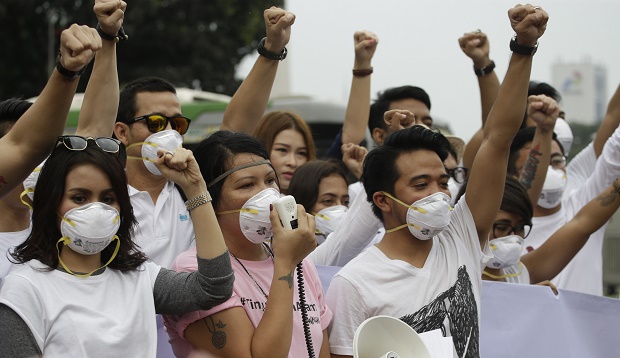
Indonesian activists wearing masks punch the air during a protest demanding Indonesian government to take quick actions to suppress the haze from wildfires on Sumatra and Borneo island which has shrouded neighboring Singapore and Malaysia, in Jakarta, Indonesia, Friday, Oct. 9, 2015. The haze highlights the regional nature of a problem that’s being blamed on Indonesia’s inability to prevent big plantation companies from burning forests to clear land for new trees. AP Photo
PALANGKARAYA, Indonesia—Desperate civilians at the epicenter of Indonesia’s haze crisis are taking the fight into the own hands, using whatever meagre resources they have to confront the fires ravaging their communities as they tire of waiting for the government to take action.
READ: Indonesia readies warships for haze evacuation
Wearing an oversized T-shirt and ill-fitting rubber boots, 13-year-old Yosua Oktavianus assisted his father douse a fire burning outside their hometown in Borneo as acrid smoke belched from the scorched earth.
“I just want to help my dad,” he told AFP near Palangkaraya, a city of 240,000 where respiratory illnesses have soared as the smog has worsened in recent weeks.
Communities worst exposed to the toxic smog are becoming increasingly frustrated at authorities in Jakarta, insisting not enough is being done to aid their plight.
The government has launched water-bombing raids dumping water over blazes on Borneo and neighbouring Sumatra but has failed so far to bring thousands of fires under control.
READ: Warships ready to move people affected by haze in Indonesia
It has also sent warships to Kalimantan—Indonesia’s half of Borneo island—in case large-scale evacuations are needed, but many on the ground are choosing to fight not flee, using wooden sticks, pails of water and anything else on hand to douse the flames.
‘Fed up of waiting’
After watching children and the elderly in his hometown fall sick under the pall of haze—just some of the estimated half a million people who have suffered respiratory illnesses since the fires started in July—20-year-old Fery Auyadi decided enough was enough.
Banding together with his friends, the college students pooled their resources and collected donations for supplies before heading to the fire front.
“My friends and I were fed up of waiting for the government to act,” he told AFP, dripping in sweat and mud as he battled a blaze outside Palangkaraya.
“It is now everybody’s fight.”
Another team in the area responded to reports of new fires and set off in pickup trucks, passing through a ruined, smoking landscape of charred earth and smouldering tree stumps.
The team scrambled to find water, a scarce resource on these tinder-dry peatlands, until a well was found at a nearby construction site.
As the team assembled the water pump, Sayban, who was wearing neither a firesuit or proper mask, stomped the smoking ground.
“At least my boots are heat resistant,” the firefighter, who like many Indonesians goes by one name, told AFP.
Just as the ten-strong team arrived, reports of another blaze breaking out nearby came in. Working around the clock on a tight budget, and with limited equipment at hand, they know if the fires become too big they can do nothing but stand by and watch it burn.
In Palangkaraya, where many have fled since the smoke blanketing their town turned an eerie yellow, there are calls for those responsible for this environmental catastrophe to be punished, but local authorities are reluctant to point fingers.
Fires are deliberately lit every year by farmers seeking to quickly and cheaply clear their land to plant crops, particularly palm oil and pulp and paper plantations, but this year’s blazes are on track to become the worst on record.
A prolonged dry season has seen widespread fires sweep Kalimantan and Sumatra, destroying 1.7 million hectares and killing ten people so far, some of whom died while fighting the blazes and others from the pollution.
Who is to blame?
Indonesia last month revoked the licence of a timber supplier and suspended the operations of three palm oil plantation operators over the fires, which have sent haze as far as Thailand and the Philippines, but catching people on the ground has proved far more difficult.
Angry residents in the heart of the haze crisis have blamed both major corporations and local farmers for the disaster, and want justice served.
“If you want to stop this disaster from happening again, you need to put the culprits in jail for a long time, revoke their license and confiscate their lands,” local resident Andi told AFP.
The local government conservation agency in Palangkaraya declined to answer when asked by AFP who was behind the massive blazes, and why more perpetrators weren’t being caught.
“It’s not the time to point fingers, it’s the time to act,” agency head Nandang Prihadi said.
But conservation group Borneo Futures said it was unlikely internationally-listed companies were responsible for the fires.
Scientist Erik Meijaard said medium-scale plantation owners trying to expand their land may have asked farmers to burn the land on their behalf.
“So who is to blame? The guy who brings the jerrycan with fuel and a box of matches, the guy paying him to do that, or the company or politicians behind the people who pay?” he told AFP.
“Difficult to see and probably very context dependent.”